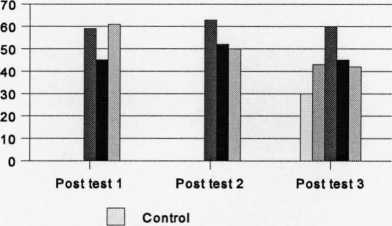Analysis of the Perceptual justifications
Is there a differential impact of the type of exposure to new lexical items that the children
receive on their provision ofperceptual justifications?
By considering children’s responses by group there were 104 for each group if they provided
“perceptual” justifications for all the four target words. The Ostensive definition and
Definition groups during post test 1, provided more “perceptual'' justifications than the other
groups. However, in post tests 2 and 3 the Definition group decreased the number of
“perceptual” justifications while, the Ostensive definition group still provided more
“perceptual” justifications than the other groups. The Control group did not provide many
“perceptual” justifications. Figure 7.19 below shows the distribution of “perceptual”
justifications by group across testing.
Figure 7.19 Provision of perceptual justifications by group across testing

∏ Phonological control
■ Ostensive definition
H Lexical contrast
I I Definition
Three One Way Analyses of Variance were carried out. Each time, group was the
independent variable and score in the “perceptual” justifications was the dependent variable.
No significant differences were found.
Do children ,s provision ofperceptual justifications increase with increased exposure to the
lexical items?
All the children tended to provide more “perceptual” justifications across testing, however
the differences were not significant. The same analysis was repeated separately for each of
the experimental groups. The Definition group provided significantly fewer “perceptual”
justifications in post test 3 than post test 1 (t=2.56, df=25, p<.05).
241
More intriguing information
1. The name is absent2. The name is absent
3. The name is absent
4. Human Resource Management Practices and Wage Dispersion in U.S. Establishments
5. 5th and 8th grade pupils’ and teachers’ perceptions of the relationships between teaching methods, classroom ethos, and positive affective attitudes towards learning mathematics in Japan
6. fMRI Investigation of Cortical and Subcortical Networks in the Learning of Abstract and Effector-Specific Representations of Motor Sequences
7. Running head: CHILDREN'S ATTRIBUTIONS OF BELIEFS
8. Spousal Labor Market Effects from Government Health Insurance: Evidence from a Veterans Affairs Expansion
9. Pupils’ attitudes towards art teaching in primary school: an evaluation tool
10. The name is absent